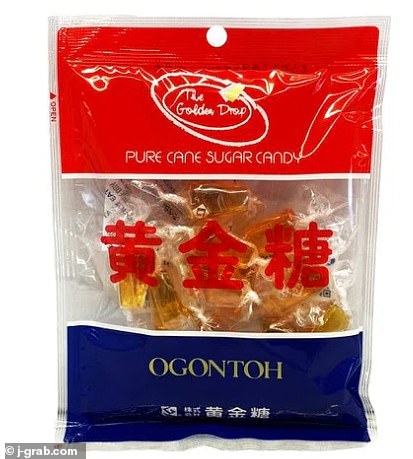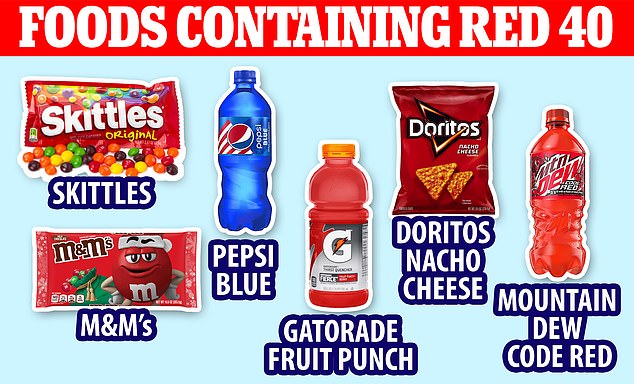A popular candy sold across the US is being recalled for containing a banned ingredient linked to cancer.
Golden Crop Candy, which was imported from China by New York-based Blooming Import Inc, was found to contain Acid Red 18 as a colorant.
The candies, which are described as having a ‘golden color and sweet aroma’, are predominantly stocked at Asian food stores.
The dye, commonly used in industries to color materials like leather, plastic, wood, medicine, and cosmetics, has been prohibited in the US due to research indicating its connection to hyperactivity and cancer.
Not only did the candies contain this banned dye, but they were also found to have Blue 1 and Red 40, additives permitted by the FDA, though not disclosed on the product packaging.
For years, these dyes have been employed in American food production to enhance the appearance of various treats. However, recent apprehensions have surfaced regarding their impact on health, as animal studies have suggested a potential link to hyperactivity, cancer, and other health issues.
European countries have already banned them or heavily restricted their use, requiring warning labels disclosing the health risks.
The FDA notes that some individuals might have allergies to color additives and therefore, they should be clearly labeled on products.

A popular candy sold across the US is being recalled for containing a banned ingredient linked to cancer
Blooming Import Inc. voluntarily initiated a recall of its 10-ounce Golden Crop Candy, which were distributed in eight US states; New York, Pennsylvania, Maryland, New Jersey, Massachusetts, Missouri, Delaware and Texas.
The affected product - which applies to both wrapped and unwrapped versions of the sweets - has the unique product codes 73476513450 and 734765134587.
There were 74 cases of the compromised candies distributed to stores, but it is unclear how many bags of sweets were in each case.
The FDA has categorized the recall as a Class II, describing it as ‘a situation in which use of or exposure to a violative product may cause temporary or medically reversible adverse health consequences.’
Customers can report an adverse event or problem with an FDA-regulated product to a consumer complaint coordinator.
It comes as health secretary Robert F Kennedy Junior appears set to remove them from sweets, cakes and other treats sold in the US.
The new HHS boss is due to give press conference later today where he’ll reveal how he plans to remove petroleum based dyes from us food - including Blue 1, Red 40, and Yellow 6.
The dyes are known as petroleum based because they are often made by combining a product from petrol with another substance to create the brilliant color.
Natural alternatives are available, and are already used in multiple products in Europe - including in Skittles.

Golden Crop Candy, which was imported from China by New York-based Blooming Import Inc, was found to contain Acid Red 18 as a colorant

Red 40, also known as Allura red, is in several popular candies, sodas and chips - including Doritos, Skittles, and Pepsi - as well as baked goods and cake mix
The dyes have been linked to multiple health problems in animal studies, including cancer and a higher risk of developing tumors.
There are also concerns that the bright colors could encourage people to eat more sweet treats, leading to weight gain which is linked to a whole host of chronic diseases.
It follows moves from the states, with both California and West Virginia passing laws to ban some artificial food colorings. There are at least 30 others, mostly Democrat, considering similar legislation.
The FDA recently ordered that Red 3 must be removed from foods sold in the US by 2027 and medications by 2028, over concerns it can cause cancer.
This dye is responsible for the bright red colors found in candies and lollipops, although there are now natural alternatives.
Many states are also seeking a ban on Red 40, or Allura red - found in several popular snacks including Doritos, Skittle and Pepsi.
Yellow 5 is also on the chopping block, which has been linked to potentially triggering hyperactivity in children and damage to DNA. It is also used in Doritos, juices and cookies.
Similarly, Yellow 6 - found in sugary breakfast cereals like Lucky Charms - and Blue 1 - found in sweets like gummy bears - have both also been linked to hyperactivity.
Studies in animals have also suggested that Blue 2 - found in sports drinks - and Green 3 - often found in salad dressings - raised the risk of tumors developing, particularly in the bladder and testes.

